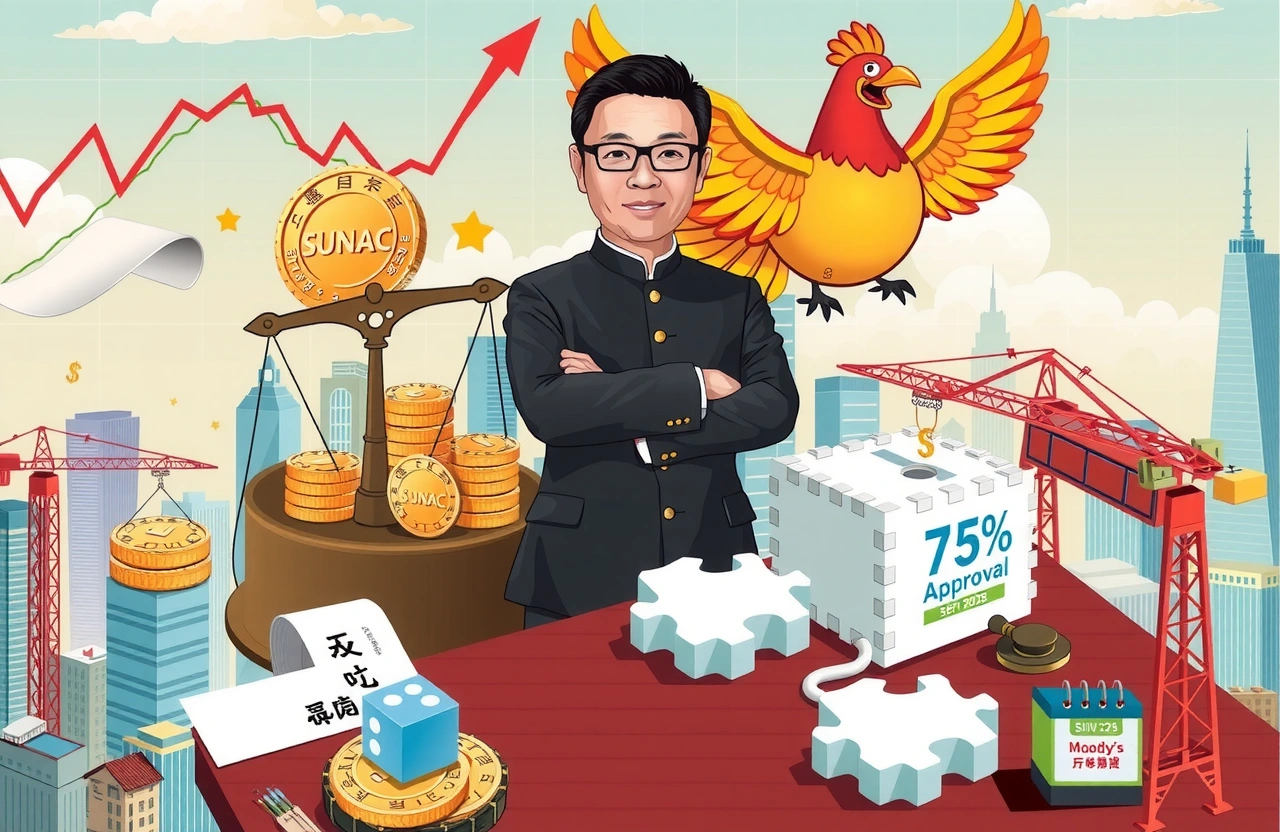Sunac’s Landmark Debt Restructuring Progress
Sun Hongbin’s (孙宏斌) unexpected presence at Sunac China Holdings Ltd’s (01918.HK) annual shareholders’ meeting on July 3rd instantly captured market attention—the company’s embattled chairman hadn’t been seen publicly since the developer’s liquidity crisis peaked in 2022. His reappearance coincided with Sunac’s announcement of decisive progress in its debt restructuring plan, notably a share issuance program addressing RMB 5.6 billion ($785 million) in domestic liabilities. For China’s crisis-ridden real estate sector, Sunac’s advancing restructuring efforts represent one of the most significant developments in 2025.
The Shanghai-based developer’s strategic moves come amidst lingering uncertainty across China’s property market, where sector-wide defaults exceeded $130 billion since 2021. According to Moody’s latest industry assessment, effective debt restructuring plans have become critical for developers to regain financial viability. Sunac’s explicit commitment to converting liabilities into equity demonstrates the practical mechanisms successful restructuring requires—this $9.55 billion dual-track resolution could potentially establish a template for distressed firms. Real estate analysts unanimously consider Sunac’s restructuring advances highly consequential for sector-wide recovery.
Analysis of Sunac’s Domestic Restructuring Approach
The Share Issuance Mechanics
Sunac China’s July 4th Hong Kong exchange filing revealed hard-won progress: A special purpose vehicle will subscribe to 754.5 million new shares, representing 7.04% of enlarged capital. Crucially:
-
– Proceeds directly repay bondholders choosing “stock options” under existing terms
– Shares priced to settle RMB 7.41 per yuan-equivalent principal
– Settlement equates to HK$8.05/share—a 440% premium over July 3rd trading price
This execution marks Phase 1 implementation of January’s approved framework, benefiting domestic creditors holding RMB 15.4 billion ($2.17 billion) in liabilities. Pacific Credit Advisors’ restructuring specialist Michelle Tang observes: “The debt restructuring plan’s share issuance structure provides creditors optionality while enabling faster capital cleanup—the premium valuation incentivizes participation despite dilution.”
Four-Path Restructuring Framework
Sunac’s multi-pronged approach includes:
-
– Cash settlement: Partial principal repayment
– Equity equivalence: Share grants proportional to claim amounts
– Asset transfers: Property-for-debt swaps
– Deadline extensions: Amortizing repayments through 2028
The stock-centered settlement exceeds initial projections—only RMB 3.7 billion conversions were anticipated. This unexpectedly strong creditor support validates Sunac’s debt restructuring plan viability. Corporate filings confirmed bondholders representing over 93% of eligible claims approved January’s restructuring framework.
Impacts on Ownership Structure
The equity issuance reshapes Sunac’s shareholder hierarchy significantly:
| Shareholder | Pre-Issuance Stake | Post-Issuance Stake |
|---|---|---|
| Sun Hongbin (孙宏斌) | 25.59% | 23.90% |
| Major Institutional Investors | 34.15% | 31.89% |
| Creditor Conversion Group | 0% | 6.58% |
While dilutive to existing holders, this restructuring aligns with successful precedents where creditor-equity conversions enabled viability restoration. Notably, China Fortune Land Development achieved post-restructuring profitability following a similar equity conversion approach.
Offshore Debt Restructuring Strategy
Special Provisions for Stability
The $9.55 billion offshore restructuring utilizes dual-mandatory convertible bonds:
-
– Existing claims fully converted: Zero cash recovery
– Majority creditors: Standard convertible instruments
– Major shareholders: Special restricted bonds (23% allocation)
Strategic restrictions apply to shareholder bonds—converted shares carry voting limitations until 2031. Sunac CFO Zhi Wei Huang confirmed this prevents destabilizing ownership transfers during stabilization.
Current Milestones Achieved
Implementation requires:
-
– Holders representing 75%+ by value: Already secured per July filings
– Hong Kong court sanction: Scheduled September hearing
– Regulatory approvals: CSRC coordination ongoing
Offshore creditors receiving conversion documentation face June 30, 2026 election deadlines: Holders retain optionality between two conversion index structures. HSBC strategists note: “Successful offshore closure eliminates Sunac’s single largest barrier to operational normalization.”
Leadership Significance: Sun Hongbin’s Strategic Visibility
Sun Hongbin’s (孙宏斌) conspicuous shareholder meeting attendance—his first since emergency deleveraging began—signaled management’s confidence. The chairman remains pivotal:
-
– Personally guaranteeing RMB 4.8 billion debt settlements
– Driving Beijing-based negotiations with municipal regulators
– Maintaining supplier/contractor confidence during defaults
His reappearance strategically precedes September’s courtroom proceeding that could formally approve restructuring implementation. Market responses proved favorable: Sunac shares gained 8% on July 5th filings.
Sector Implications
Parallels With Other Developers
Sunac’s progressing resolution contrasts sharply with stalled efforts at competitors:
-
– China Evergrande: Failed restructuring; ongoing liquidation
– Country Garden: Restructuring suspended since January
– Shimao Group: Approval obtained but implementation lags
Deloitte China restructuring lead David Wu cites reasons: “The transparency in Sunac’s debt restructuring plan timelines, plus strategic creditor accommodation techniques, differentiated its feasibility.”
Broader Market Recovery Signals
Green shoots appear beyond Sunac: National Bureau of Statistics measurements show:
-
– May 2025 property transactions: 26% YoY increase
– Tier-1 city price declines narrowing: -0.7% vs. -3.2% year-prior
Tianfeng Securities cautions optimism: “Developers’ viability restoration requires combined debt restructuring completion AND sustained policy stimulus—currently the latter remains inconsistent.”
Future Roadmap
Successful restructuring execution now depends on:
-
– Achieving final court sanction in September
– Implementing operational stabilization under new structure
– Rebuilding project delivery credibility: Local monitoring necessary
– Reengaging sales channels: Project-level financing facilitation
Sunac confirms normalization targets include reinstating dividend distributions by 2027—contingent upon removing “restricted” accounting classifications through 2026 audited results.
Sector Recovery Opportunities
Sunac’s imminent emergence from restructuring presents benchmarks indicating systemic stabilization:
-
– Liquidity restoration probability tracking: Moody’s upgraded instrument viability assessment
– Follow-on restructuring viability: Creditors increasingly accommodative
– Comparative valuations: Deep distress discounts narrowing
The Hong Kong court’s September ruling may catalyze renewed property investment inflows—particularly toward top-tier developers exiting restructuring supervision. Bondholders accepting equity conversions today position advantageously for China’s inevitable residential market recovery after three years of contraction.
Actionable Pathways Forward
Evidence consistently indicates restructuring-enabled viability restoration yields asymmetric opportunity—investors anticipating China’s property recovery should urgently:
-
– Track Sunac court documentation released quarterly
– Assess other developers nearing restructuring conclusion
– Position selectively within project-financing initiatives
– Monitor regional rehabilitation fund deployment
The fastest reconnaissance channel remains Hong Kong exchange disclosures (https://www.hkex.com.hk) for upcoming Sunac court submissions. Market restoration requires investor confidence—Sunac’s tangible restructuring breakthrough exemplifies credible evidence supporting renewed sector participation.




